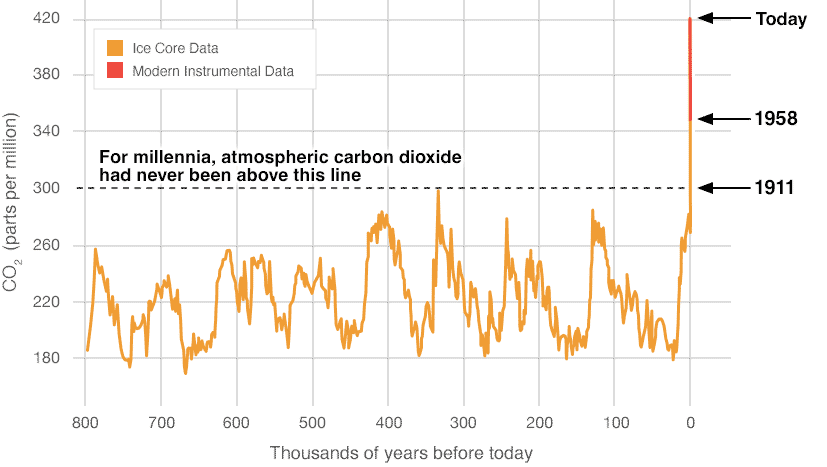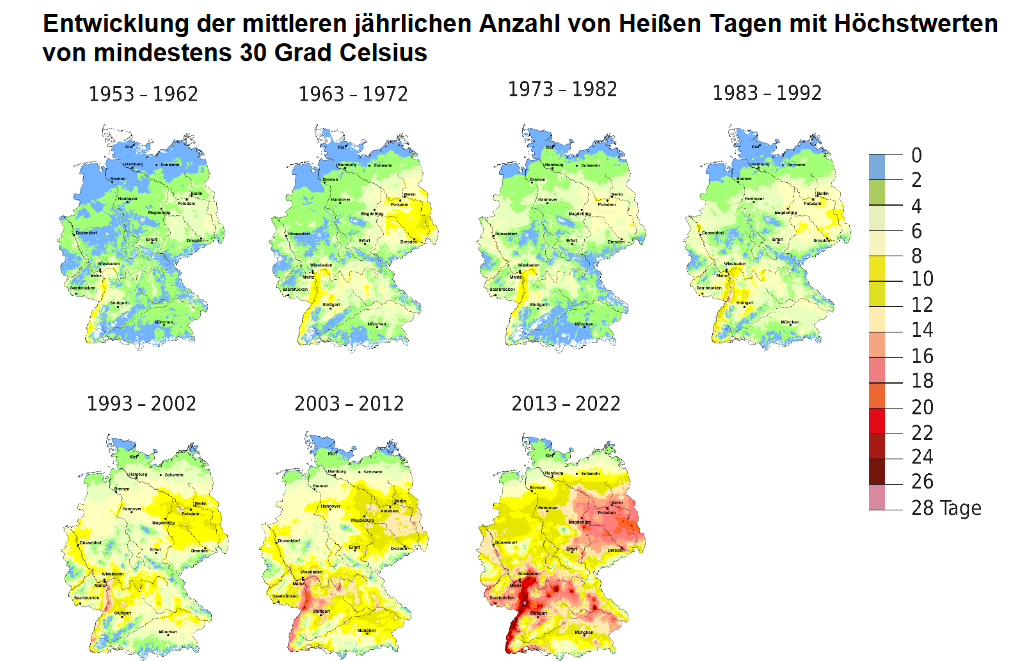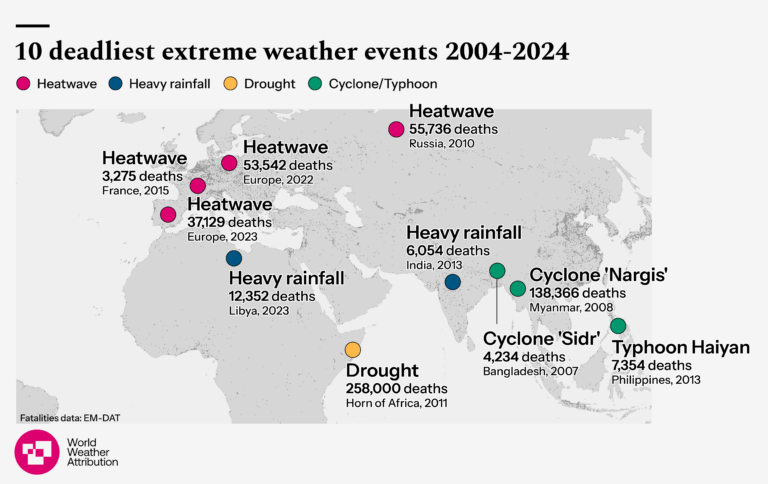Climate change and attribution research
What is climate change and what does attribution research involve? This page offers a brief overview of the topic and provides useful links.
© Hermann/Richter Pixabay
What is climate change?
Climate change and the associated climate crisis currently pose one of the greatest threats to humanity. The main effects of climate change are progressing faster than ever before. But how exactly does global warming work?
Our earth’s atmosphere is naturally made up of various gases that allow most of the short-wave solar radiation to pass through, but absorb the (long-wave) heat radiation that the earth radiates, thereby heating up the system. Water vapour and carbon dioxide in particular absorb some of the heat radiation emitted by the earth’s surface and thus reduce the proportion of heat radiation emitted into space. This so-called natural greenhouse effect causes the global average air temperature near the ground to be around 15 °C. Without greenhouse gases in the atmosphere, the average temperature would be -18 °C, making life on earth as we know it today unthinkable.
Man-made climate change intensifies this natural greenhouse effect, in which an accumulation of gases in the atmosphere leads to greater warming of the lower layers of air. The greenhouse gases caused by humans include carbon dioxide (CO2), methane (CH4) and nitrogen monoxide (N2O, nitrous oxide). Although CH4 and N2O, which are mainly produced by industry, agriculture and livestock farming, remain in the atmosphere for a much shorter period of time, their absorption potential means that they have a significantly higher warming potential (over a period of 100 years, this corresponds to a 28 times greater impact on global warming) than CO2, which is mainly accumulated during the combustion of fossil fuels and through large-scale deforestation (German Environment Agency, 2021). Since the 18th century, greenhouse gases in the atmosphere have increased significantly with the onset of industrialisation and the associated use of natural resources, which is why science refers to the pre-industrial average temperature as a comparative value for contemporary temperature changes (Klima-Wissen, 2023).
Figure 1: Proxy (indirect) measurement, CO2 concentration in ppm (parts per million) from 800,000 BC to today (NASA, 2024)
Figure 1 shows that the carbon dioxide concentration has never exceeded a value of around 300 ppm (parts per million) in the last millennia. However, since direct measurement began in Hawaii in 1958 (previous data came from ice core drilling), it has risen continuously to a new high of 427 ppm in the months of April to June 2024 (NOAA, 2024). However, this is only the CO2 concentration. No other greenhouse gases, such as methane and nitrous oxide, are considered. The effect of all greenhouse gases is regularly converted into CO2eq (carbon dioxide equivalents) for better understanding. This value expresses the warming effect of a certain amount of a greenhouse gas over a fixed period of time (usually 100 years) compared to that of carbon dioxide. Example: In 2021, the CO2eq value was 508 ppm (German Environment Agency, 2023) compared to the pure CO2 content of 415 ppm in the same year (Our World in Data, 2024).
Compared to pre-industrial levels, anthropogenic greenhouse gases have already caused an increase in the average global surface temperature of 1.1 °C in the period between 1880 and 2023 (NOAA, 2024). If global warming continues, an increase to 1.5 °C is expected between 2030 and 2052, which will result in massive regional climatic changes, such as extreme heat waves (IPCC, 2018). The Intergovernmental Panel on Climate Change (IPCC) states that it is almost certain that heat extremes have become more frequent and more intense and cold extremes less frequent and less severe since the 1950s. Researchers conclude that it is highly likely that anthropogenic climate change is the main driver of these climatic changes (IPCC AR5 WG I 2021).
The climatic influence on weather phenomena using the example of El Niño
Climatic changes, such as rising air temperatures, can also have an impact on meteorological phenomena. One example of this is the El Niño (warm cycle) and La Niña (cold cycle) phenomena in the South Pacific, which have a significant influence on global weather. The impact of climate change on these two natural weather phenomena is not serious, but should nevertheless be taken into account in analyses. In this context, a group of researchers found that the uppermost water layer of the ocean heats up faster due to climate change and thus has a stronger influence on the wind currents over the Pacific, which can make the typical El Niño weather patterns more extreme (Cai, 2018).
Difference between weather and climate
Is this weather or climate?
The sun is shining, it’s 18 °C and there are hardly any clouds in the sky. That’s our weather! It is a local weather condition at a specific point in time or for a short period of time, i.e. the current physical state of the atmosphere. This includes quantifiable parameters such as air temperatures and air pressure, precipitation, humidity or wind speed (DWD). Climate, on the other hand, is a summary of weather phenomena over a longer period of time that characterise the average state of the atmosphere (which is why the term (global) average temperature is used). The overall statistical characteristics (mean values, extreme values, frequencies, duration values, etc.) are used to analyse a longer period of time, usually 30 years. However, shorter or longer time periods are also important when analysing the climate (DWD).
What is the IPCC?
The Intergovernmental Panel on Climate Change (IPCC), also known as the Intergovernmental Panel on Climate Change, is an intergovernmental committee on climate change. The IPCC was established in 1988 by the United Nations Environment Programme (UNEP) and the World Meteorological Organisation (WMO) and thus works under the umbrella of the United Nations. The central tasks of the IPCC are to summarise scientific research on climate change for political decision-makers and also serves as input for international climate negotiations. This involves the scientific assessment of the effects of global warming and its risks as well as mitigation and adaptation strategies, which are summarised in an assessment report. The research is divided into three working groups: Natural Science Basis of Climate Change (WG I), Consequences of Climate Change, Vulnerability and Adaptation (WG II) and Mitigation of Climate Change (WG III). The IPCC currently has 195 member states and thousands of researchers from all over the world who contribute to the reports and analyse the state of knowledge through voluntary commitment (IPCC, 2021).
Climate change in germany
In Germany, we have already reached an average warming of 2 °C (see Figure 2). Furthermore, we are experiencing a significant increase in record heat years in Germany (see Figure 3). Nine out of ten of the hottest years since weather records began in 1881 have occurred after the year 2000. The current hottest year in Germany was 2023 with an average temperature of 10.6 °C (DWD). However, the previous year had already surpassed numerous previous measurements. In 2022, daily highs of over 30 °C were recorded in Hamburg for eight days in a row, making it one of the longest consecutive days of uninterrupted heat at this location since 1891. At the end of July 2022, a record temperature of 40.1 °C was also measured in Hamburg, a temperature that has never been measured in such a northern part of Central Europe (DWD and ExtremWetterKongress, 2023). An increase in the frequency and intensity of heavy rainfall events is also physically possible due to the increasing water holding capacity of the atmosphere with higher temperatures. Heavy precipitation analyses by the German Weather Service (DWD) show increasing trends, but due to the large temporal and spatial variability of precipitation and the fact that some measurement time series are still too short, no statistically reliable changes indicate that an increase in heavy rainfall could be a further consequence of climate change in Germany. So far, the radar-based data series for sub-daily heavy rainfall events is too short to derive statistically reliable trends (DKK et al., 2023). This shows that climate change affects many areas of life and not just life outside Germany.
Figure 2: Deviation of the temperature for Germany and worldwide from the long-term average 1961-1990 (DWD)
Figure 3: Average annual number of hot days (i.e. days with a maximum temperature of at least 30 °C.) (DWD)
Attribution research
In connection with rising global temperatures as a result of human activity, a change in the probability of occurrence of extreme meteorological and climatological events is also expected. For example, according to a simple physical principle, the warmer the air is, the more water vapour it can absorb. As a result, the potential for heavy precipitation generally increases. However, other factors are always responsible for the actual occurrence of heavy precipitation, so that despite these conditions, there is not necessarily an increase in the frequency of such events. Rather, regional differences are to be expected, both on the global scale and on the national scale in Germany. The same principle essentially applies to other extreme events such as storms or heatwaves. Here too, other factors, such as a possible change in global circulation, determine the extent to which a particular region is actually affected by such changes. Accordingly, there is growing interest in the actual extent of climate change influence on extreme events. This raises the question of whether and, if so, to what extent progressive global warming has already changed the frequency and characteristics of extreme weather events. In addition, policy-makers and society also need an estimate of the future impact of extreme weather events.
It is easy to evaluate meteorological data measured in the past. However, researchers quickly encounter challenges in practice. Firstly, extreme events are rare by definition. Ultimately, the climate is always subject to natural fluctuations. This so-called ‘natural (or internal) climatic variability’ is superimposed on the human-induced component, which currently makes it impossible to clearly attribute it. Overall, therefore, very long observation time series are required for the successful detection of changed frequencies using extreme value statistical methods, which are not yet available in most cases.
The science of attribution offers an alternative. The Latin term attribution refers to the assignment of characteristics. It is based on the assumption that a cause-and-effect relationship actually exists. In the field of climate science, it is specifically investigated whether the ongoing climate change has already led to a change in the frequency of extreme events. This field of research is still very young. There is a great deal of interest in this topic worldwide. This is all the more true as the methodology can also be used to derive statements for the future.
The results of the research are used to inform important target groups in politics, science, and society with scientific findings. As questions are often asked about the connection between climate change and the occurrence of extreme events, attribution research aims to provide evidence-based answers to this question. In addition, the research aims to inform the population about the increasing risk potential of extreme events and the associated potential risk reduction for future events.
The approach to an attribution study is therefore as follows:
- The event is defined. A location and time reference applies here.
- This is followed by an analysis of whether the event can be simulated by climate models and whether the observed frequencies are reproduced. If yes, then:
- The probability of occurrence is analysed in the data sets with and without climate change. Question: Does a change occur and if so, is it robust?
- Finally, the results are communicated and the underlying assumptions and chosen procedure for preparing the study are documented.
Extensive data sets are required for this study. In order to analyse the influence of climate change, these climate simulations are carried out several times, once using all known human influences and once without taking man-made climate change into account (DWD). By directly comparing both worlds, a possible difference in the frequency and intensity of extreme natural events can be attributed to man-made climate change. After analysing the differences, the probability of occurrence of extreme natural events and their differences in intensity can be determined. This illustrates how high the probability of occurrence and intensity of an extreme event is in a particular region.
According to this, a heatwave like the one in Germany in 2019 occurs approximately every 10-30 years. Without the influence of anthropogenic climate change, such an event would have had a return period of several decades to 100 years and would have been up to 1.5-3 °C cooler (WWA, 2019). Climate change had an even greater impact on the heatwave in July 2023 in the south-west of the USA, Mexico, Southern Europe, and China.
In July 2021, heavy rainfall across large parts of Western Europe caused severe flooding, high socio-economic damage and almost 200 fatalities. Regions in Belgium, North Rhine-Westphalia and Rhineland-Palatinate were particularly affected. A consortium of researchers from Germany, Belgium, the Netherlands, Switzerland, France, Luxembourg, the USA, and the UK jointly analysed the event, focusing in particular on the regions along the Ahr and Erft rivers and the Belgian Meuse. The researchers came to the conclusion that the probability of an event like the one that occurred in Western Europe in 2021 increased by a factor of between 1.2 and 9 compared to a 1.2 °C cooler climate. In terms of intensity, an increase of 3-19 % could also be attributed to climate change (Kreienkamp, 2021 and Tradowsky, 2023). Although the researchers came to this conclusion using scientifically recognised methods, the wide range shows the uncertainties involved in the attribution of extreme weather events.
Over the last ten years, attribution research has developed significantly. The WWA study ‘10 years of rapidly disentangling drivers of extreme weather disaster’ analyses the ten deadliest weather extremes between 2004 and 2024, including four heatwaves, three tropical cyclones, two heavy rainfall events and one drought, which together claimed over 570,000 lives. The impact of the climate crisis was detected in all of these events.
It is striking that four of the analysed events involved heatwaves in Europe – despite good precautionary structures such as early warning systems and heat action plans. However, these measures proved to be insufficient to cope with the growing risks.
Limitations
Although climate models and the studies based on them provide many results and new findings, attribution research is still reaching its limits in some cases. There are many aspects of extreme events for which there is insufficient scientific knowledge to reliably estimate the probability of extreme events and their changes. While attribution research can determine the influence of anthropogenic climate change relatively well for climatological events such as heatwaves, it is currently not possible to attribute smaller individual events such as tornadoes, flash floods, or hailstorms. Another challenge for attribution research is the regional differences in the quality of climate models. If countries have extensive and high-quality data on local climate and weather conditions, this forms a good basis for carrying out attribution studies. If this is not the case, attribution research becomes more difficult, which mostly affects countries in the Global South. However, higher socio-economic damage can occur there due to increased vulnerability and comparatively fewer coping mechanisms (Otto, 2020).
As the immediate weeks following an event are the most important in terms of providing information about its basis, attribution research places particular emphasis on publishing its results as quickly as possible. In most cases, this happens even before the study has undergone a peer review process (although published peer review methods are used), as such a process usually takes several months to years. As a result, the findings are not initially regarded as scientific consensus, but serve as an important source of information and clarification (Van Oldenborgh, 2021).
Whether an extreme weather event causes major socio-economic damage or even leads to a disaster depends on various influencing factors that are of essential importance (see Figure 4). Disasters are always the result of many different factors. The resilience and vulnerability of a society always has a significant influence on the consequences of a weather event.
Figure 5: Aspects of risk (IPCC, 2021)
Created: October 2024
Current information
No Results Found
The page you requested could not be found. Try refining your search, or use the navigation above to locate the post.
Further information
DKKV
Additional Links
- LAWA – Heavy rainfall documentation – Homepage (starkregenportal.de)
- Intergovernmental Panel on Climate Change (IPCC): Special Report 1.5 °C Global Warming
- Intergovernmental Panel on Climate Change (IPCC): Special Report on Climate Change and Land Systems
- Friederike Otto: Attribution of extreme weather events: how does climate change affect weather?
- Attribution research at DWD
- Published attribution studies of the DWD







